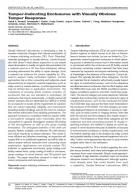Details
- Identification
- ISSN: 1977-5296, DOI: 10.3011/ESARDA.IJNSNP.2019.6
- Publication date
- 1 June 2019
- Author
- Joint Research Centre
Description
Volume: 58, June 2019, pages 48-54,
Authors: Heidi A. Smartt, Annabelle I. Benin, Cody Corbin, Joyce Custer, Patrick L. Feng, Matthew Humphries, Amanda Jones, Nicholas R. Myllenbeck
Sandia National Laboratories
Abstract:Sandia National Laboratories is developing a way to visualize molecular changes that indicate penetration of a tamper-indicating enclosure (TIE). Such “bleeding” materials (analogous to visually obvious, colorful bruised skin that doesn’t heal) allows inspectors to use simple visual observation to readily recognize that penetration into a material used as a TIE has been attempted, without providing adversaries the ability to repair damage. Such a material can enhance the current capability for TIEs, used to support treaty verification regimes. Current approaches rely on time-consuming and subjective visual assessment by an inspector, external equipment, such as eddy current or camera devices, or active approaches that may be limited due to application environment. The complexity of securing whole volumes includes: (1) enclosures that are non-standard in size/shape; (2) enclosures that may be inspectorate- or facility-owned; (3) tamper attempts that are detectable but difficult or timely for an inspector to locate; (4) the requirement for solutions that are robust regarding reliability and environment (including facility handling); and (5) the need for solutions that prevent adversaries from repairing penetrations. The approach is based on a transition metal ion solution within a microsphere changing color irreversibly when the microsphere is ruptured. Investigators examine 3D printing of the microspheres as well as the spray coating formulation. The anticipated benefits of this work are passive, flexible, scalable, cost-effective TIEs with obvious and robust responses to tamper attempts. This results in more efficient and effective monitoring, as inspectors will require little or no additional equipment and will be able to detect tamper without extensive time-consuming visual examination. Applications can include custom TIEs (cabinets or equipment enclosures), spray-coating onto facility-owned items, spray-coating of walls or structures, spray-coatings of circuit boards, and 3D-printed seal bodies. The paper describes research to-date on the sensor compounds and microspheres.
Keywords: tamper-indicating enclosures; international nuclear safeguards.
Reference guideline:
Smartt, H.A., Benin, A.I., Corbin, C., Custer, J., Feng, P.L., Humphries, M., Jones, A., & Myllenbeck, N.R. (2019). Tamper-Indicating Enclosures with Visually Obvious Tamper Response. ESARDA Bulletin - The International Journal of Nuclear Safeguards and Non-proliferation, 58, 48-54. https://doi.org/10.3011/ESARDA.IJNSNP.2019.6

